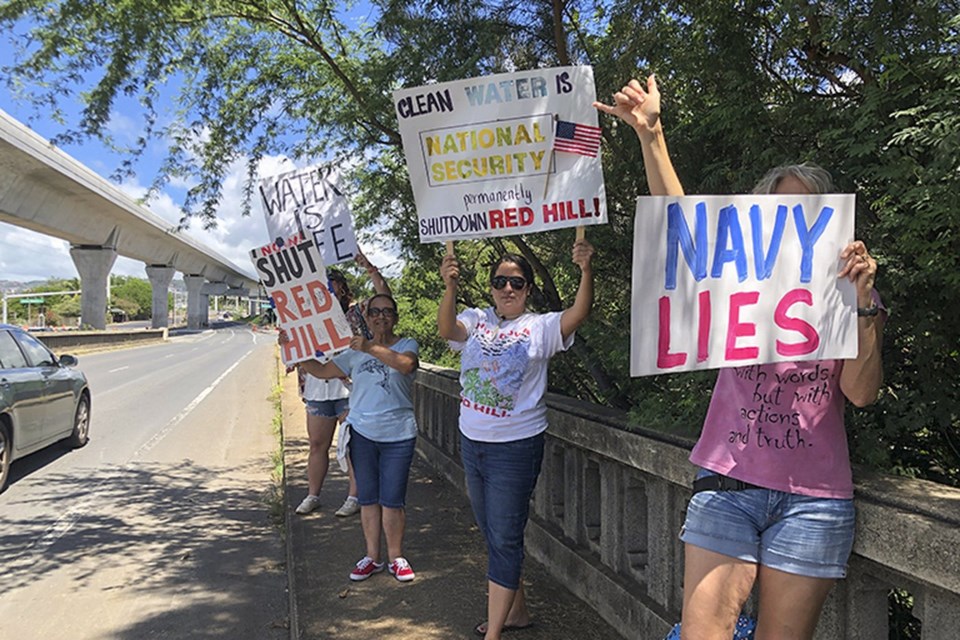HONOLULU (AP) — Navy officials “lacked sufficient understanding” of the risks of maintaining massive fuel storage tanks on top of a drinking water well at Pearl Harbor where spilled more than in 2021, a U.S. military watchdog said Thursday.
That lack of awareness came even though officials had engineering drawings and environmental studies that described the risks, the U.S. Department of Defense’s inspector general said.
The finding was among a long list of Navy failures identified by the inspector general in two reports that follow a yearslong investigation into at the Red Hill Bulk Fuel Storage Facility. Investigators said it was imperative for the Navy to address its management of fuel and water systems at Joint Base Pearl Harbor-Hickam and recommended that the military assess leak detection systems at other Navy fuel facilities.
"The DoD must take this action, and others, to ensure that tragedies like the one in November of 2021 are not allowed to repeat,” Inspector General Robert P. Storch said in a statement.
The military built the Red Hill fuel tanks into the side of a mountain in the early 1940s to protect them from aerial attack. There were 20 tanks in all, each about the height of a 25-story building with the capacity to hold 12.5 million gallons (47.3 million liters.) The site was in the hills above Pearl Harbor and on top of an aquifer equipped with wells that provided drinking water to the Navy and to Honolulu's municipal water system.
Fuel leaks at Red Hill had occurred before, including in 2014, prompting the Sierra Club of Hawaii and the Honolulu Board of Water Supply to the tanks to a place where they wouldn't threaten Oahu's water. But the Navy refused, saying the island's water was safe.
The 2021 spill gushed from a ruptured pipe in May of that year. Most of it flowed into a fire suppression drain system, where it sat unnoticed for six months until a cart rammed a sagging line holding the liquid. Crews believed they mopped up most of this fuel but they failed to get about 5,000 gallons (19,000 liters.) Around Thanksgiving, the fuel flowed into a drain and drinking water well that supplied water to 90,000 people at Joint Base Pearl Harbor-Hickam.
The inspector general's report noted 4,000 families had to move out of their homes for months because they couldn't drink or bathe in their water. The military spent more than $220 million housing residents in hotels and responding to the spill. Congress appropriated $2.1 billion more, some of which is helping the Navy in compliance with an .
Among the inspector general's other findings:
1. The Navy never told the state Department of Health, which regulates underground fuel tanks, about the missing fuel after the May 2021 spill.
2. The Navy missed four separate opportunities in November 2021 to activate emergency response plans to respond to the water contamination. That includes on Nov. 20, when fuel was released from the drainage pipe, and on Nov. 28, when residents called base authorities to report chemical and fuel smells emanating from their water.
3. The Navy issued news releases on Nov. 21 and 22 saying “the drinking water was safe” but did so without conducting any laboratory analysis to confirm that was the case.
4. The Navy didn't assume contamination from the spill had spread throughout Pearl Harbor's drinking water system, as required by the water system emergency response plan. The report said some residents may have continued to cook and shower with their tap water as a result.
Hawaii's congressional delegation, which called for the investigation in 2021, issued a joint statement saying the reports made clear the Navy and the military failed to manage fuel and water operations at Red Hill and Pearl Harbor to a standard that protects the health and safety of the people of Hawaii.
“It's outrageous and unacceptable,” said the statement from U.S. Sens. Mazie Hirono and Brian Schatz and U.S. Reps. Ed Case and Jill Tokuda, all Democrats.
They called on the Navy to take “full responsibility” for its failures and immediately implement the inspector general's recommendations.
A Navy spokesperson said in a statement that the inspector general's findings align with previous evaluations and support corrective actions the Navy is implementing.
“We are committed to constant improvement to ensure the highest standards of operation, maintenance, safety, and oversight at all of our facilities at all times,” the statement said.
The Navy last year to three retired military officers for their roles in the fuel spill in a move the Sierra Club called “slaps on the wrist.”
Hawaii Gov. Josh Green said he welcomed the inspector general's findings, which he said underscored what environmental advocates had long alleged.
"We will continue to insist on transparency and accountability surrounding the issue of Red Hill, as all people who live in Hawai ªi deserve pure, clean drinking water,‚Äù Green said in a statement.
Audrey Mcavoy, The Associated Press



